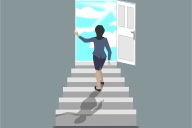You have /5 articles left.
Sign up for a free account or log in.

visual generation/istock via getty images plus
In the pre-COVID-19 days, the five minutes that my students sat quietly chatting before I put the first slide up on the screen were facilitating the smooth functioning of my classes. But I never realized that until the coronavirus hit.
My name is Zachary Nowak, and I’m a lecturer at Harvard University. In the pre-COVID-19 days, casual social bonds between students could develop without much intervention from instructors. Those few minutes before class, the walk toward the library afterwards, improvised study sessions and even crossing paths with someone from their course in another context: I have personally underestimated how important those informal, class-adjacent social interactions and the bonds that develop from them were for students to feel comfortable talking in front of their peers. My spring 2020 students had spent enough time together that I could leverage their acquaintance with each other after we went remote, but I knew many of my summer and fall students would never have met and were not going to develop that sort of acquaintance over Zoom. At least not organically.
It seemed clear to me that I would have to try to foster virtually something like what happens naturally for in-person classes. My response was to create a series of three assignments for students to do what I called “class-adjacent socializing.” My first attempt was with the students in a summer 2020 class on urban agriculture I taught as part of Boston University’s gastronomy program. I considered having students each come up with an online event to host but then discarded that idea, wondering what would happen if someone tried to hold, say, a short session on how to make kimchi and no one came.
Instead I decided I would put the students in groups of four and tell them they could talk about anything they wanted (i.e., not necessarily class related) as long as they chatted. It was all on the honor system; students would repeat the exercise twice more with randomized groups of four each time, and I would give them five points of their final grade for each meeting.
While the BU students were enthusiastic, they also pointed out the flaws in my original plan at the end of the summer term. I had not told students what digital platform to use to connect, assuming that they would just use Zoom -- and that because they could click on a Zoom link, they knew how to set up a meeting. The absence of a designated leader slowed the process of finding a time, and the lack of a specific conversation prompt on my part meant that the meet-ups were sometimes awkward. Over all, however, the students were positive in their evaluation of the assignment. It had made them, they said, more comfortable talking in front of each other because they had gotten to know each other a bit outside class.
I shared this feedback with Sarah Bramao-Ramos, the co-author of this piece and the head teaching assistant of my fall 2020 lecture course on sports history for Harvard students -- who, like the BU students, were also all remote. She and I tinkered with the instructions based on the feedback from my BU students, providing a longish, FAQ-style prompt for the class-adjacent socializing. TAs emailed groups of four students, all from the same hourlong discussion section, for each iteration of the assignment, naming one student the organizer.
We directed the students to use Zoom and provided links on how to set up meetings to the organizer for each group; the organizer also coordinated scheduling. We also added a deliverable: each organizer had to take a screenshot while everyone was on the call and send that to the TA later, with a brief (100-word) summary of the call. There would be three events, and the assignment as a whole was worth 15 percent, a significant enough portion of the grade for the students to see we were taking it seriously, we reasoned.
Rather than leaving the topic wide-open, we suggested a series of discussion themes. Among them were the following:
- Do the typical first-day-of-class thing and introduce yourself, maybe telling your peers what year you are, where you are from and why you're taking this class.
- Talk about why sports are important (or why they aren’t) in your life -- do you have relatives who were athletes?
- Describe your experiences playing on or rooting for sports teams.
- Talk about what else you do at Harvard or, if you’re a first-year, what activities/organizations you’d like to get involved in.
- When you were a kid, what were your favorite TV shows?
- What are some movies you’ve seen lately? Why did you like them or not like them?
- Read any good books lately?
- What’s the best game you’ve played lately? Board games, online, etc.
We had to reiterate, several times, that these were intended to be class-adjacent events, not class-related events. The goal was not for the students to discuss the class material: the goal was to get them comfortable enough with each other that it would be easier to have those discussions when they met online.
We knew that we were setting the bar pretty low for the whole thing to be worth a grand 15 percent of their final grade, but we decided that even if some of the groups faked it, they would at least all have to get together and agree to the deception (which still required at least some acquaintance with each other). The three meetings happened in the first four weeks of the semester. To ensure these intra-discussion section connections, we also set up the breakout rooms during lecture so that students were always with people from their discussion section.
Fostering Community
The response this time around has been overwhelmingly positive. In the seventh week of the semester, we used an anonymous Google survey to evaluate students’ feelings about the class-adjacent socializing, with 65 of the 99 students in the class responding. One student said the following in the open response question: “I really enjoyed the Class-Adjacent Socializing, and thought it was a very stress-free way to get to know the people in my section. I genuinely feel like I have met so many people in this class because of it -- way more than any of my other Zoom classes this semester.” Another said something similar: “There is no comparison for my other classes; I truly feel as if I know my classmates as I would normally. Thank you for fostering a class community.”
Not every student was a fan, of course. Some students thought it was just busywork -- yet another task to accomplish in an already-frenetic semester. Others wanted more direction, a task to complete, an activity to do, a movie to watch. A few wanted to use the activity to meet other students outside their section, asking the instructors to play matchmaker and connect them with other students based on shared interests. And some, even though they understood the goal, found the whole exercise rather pointless: “I understand the motivation for it; however, it felt tedious and just another touch point that I just didn’t want to have to deal with.” Another student, when asked if the activity should be repeated, simply wrote a dismissive “ehhh.”
Despite the critiques in the open-response questions, the quantitative data was overwhelmingly positive. When asked “To what extent has the class-adjacent socializing activities helped you get to know your section-mates, compared to how well you know the people in section(s) in other courses you're taking online?” roughly 80 percent of the students said that they knew their section mates for my class better than the people in their other sections for other classes. And more than half of them specifically responded that they knew “the people in my HIST 1852 section much better than I know my section-mates in other courses.”
For as long as we are online, all of us will face a decline in classroom community spirit because of the remote environment. We can, however, see this from the perspective of abundance: students have the tools to be able to meet up and get to know each other out of class, with our help. Even when the two of us return to in-person instruction, we will continue to actively foster these previously casual interactions. Students learning what sports, movies and ice cream flavors their peers like outside the Zoom classroom is a crucial component of good discussions later in that classroom -- something COVID has taught us.

![First text message: "Yes?" Second message: "This is embarrassing to say, but law school isn't fair for us men, the women are always outperforming us at [sic]. It's obvious women are taking over the legal profession nowadays." Third text: "Who is this?"](/sites/default/files/styles/image_192_x_128/public/2024-09/Text_messages_law_2.jpg?itok=0QWP419B)






